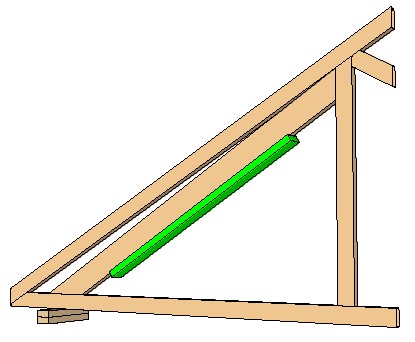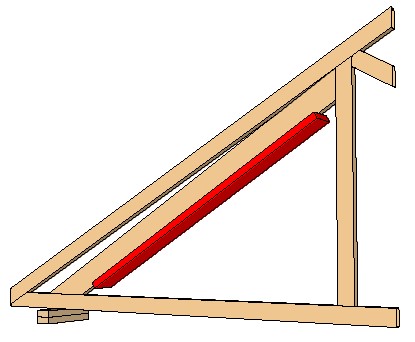Bringing in Additional Reinforcements
The new ANSI/TPI 1-2022 standard contains valuable new methodology
Building codes and construction standards are updated on a regular basis because the industry is constantly evolving and learning from field experience. In most cases, changes to codes and standards are made to address energy, engineering, and safety issues, but there are also instances in which research and development yield results that can provide more practical and economical approaches to prescriptive methods. One such case is contained in the new ANSI/TPI 1-2022, which was summarized in the January/February 2023 issue of SBCA Magazine. In the revised standard, there is a new design method for determining the most economical web reinforcement.
Web Reinforcement
Web reinforcement can be used as an alternative to continuous lateral restraints (CLR). Web reinforcement is often needed when conditions prohibit the use of CLRs; for example, when trusses are spaced far apart, or when truss webs do not align. Currently, building designers, truss manufacturers, and framers rely on Table B3-2 in BCSI (facing page), plate supplier details, or their own analysis to determine how to use web reinforcements. In most cases, these prescriptive methods serve the project well. However, there can be times when using a designed reinforcement is more practical and economical.

New Methodology
ANSI/TPI 1-2022 provides for a new design method to determine the capacity of reinforced webs such as T-, L-, I- U-, and scab reinforced webs.
The Truss Plate Institute’s Technical Advisory Committee (TPITAC) developed this method to predict the design capacity of reinforced web members in metal plate connected wood trusses (MPCWT). Methods for analyzing built-up wood sections have always been available, but reinforced web members in trusses present a unique condition. Only the web member itself is in compression, while the reinforcement merely provides resistance to buckling. The new method developed by TPITAC not only includes consideration of the size and configuration of the reinforcement, but also takes into account the length and grade of the attached member. This allows for very economical solutions.
The table below provides some examples of how this new calculated method in ANSI/TPI 1-2022 will increase flexibility for the truss designer.
 Saving Money and Material
Saving Money and Material
 FIGURE 1: An 8’4”reinforcement is required using the prescriptive method
FIGURE 1: An 8’4”reinforcement is required using the prescriptive method
Here are some simple examples of how this new calculated approach could lower the cost of web reinforcement solutions.
Example 1:
Use of common-length lumber for reinforcements
The diagonal web in the figure below is 9’ 3”, which requires an 8’ 4” reinforcement per the prescriptive method, meaning the framer would need to cut a 10’ board for this reinforcement. The calculated approach allows a designer to verify that any common 8’ reinforcement is adequate (Figures 1 and 2).
Example 2:
 FIGURE 2: An 8’ reinforcement works with calculated method
FIGURE 2: An 8’ reinforcement works with calculated method
Use of field-grade lumber for reinforcements
Truss designs often specify premium grade lumber for truss members (e.g., SP Select Structural). However, high-grade lumber is often difficult to source and not readily available on the jobsite. A framer needs to special order lumber for the reinforcements since the prescriptive method requires the grade of the reinforcement to match the grade of the web. A calculated approach would allow a designer to specify field-grade lumber for web reinforcement purposes.
Example 3:
Use of economical lumber for reinforcements
Figure 3 shows a cantilevered truss with a high grade 2x6 kicker web. If a T-reinforcement is to be used as an alternative to the CLR, it would need to be a 2x6 per the prescriptive method. However, with the web reinforcement design procedure in ANSI/TPI 1-2022, a truss designer could determine if it is acceptable to use an economical-length 2x4 T-reinforcement for this condition.
 FIGURE 3: Left, 2x6 reinforcement required for 2x6 web per the prescriptive method. Above, a shorter 2x4 reinforcement may work on the 2x6 web per the calculated method.
FIGURE 3: Left, 2x6 reinforcement required for 2x6 web per the prescriptive method. Above, a shorter 2x4 reinforcement may work on the 2x6 web per the calculated method.
Looking Ahead
The ANSI/TP1-2022 Standard will be available later in 2023, and will be referenced in the 2024 ICC model codes. Although jurisdictions typically don’t adopt model codes as soon as they become available, the information contained in ANSI/TPI 1-2022 is the most current thinking in the industry, so that design software providers may start implementing the option sooner. Engineers have the option to approve
this method as soon as the standard is published, so look for the announcement soon.
This article is the result of a collaboration between the members of the Truss Plate Institute’s Technical Advisory Committee (TPITAC) and SBCA. It is part of a technical article series driven by TPITAC members that seeks to address pertinent engineering topics and provide design best practices.
